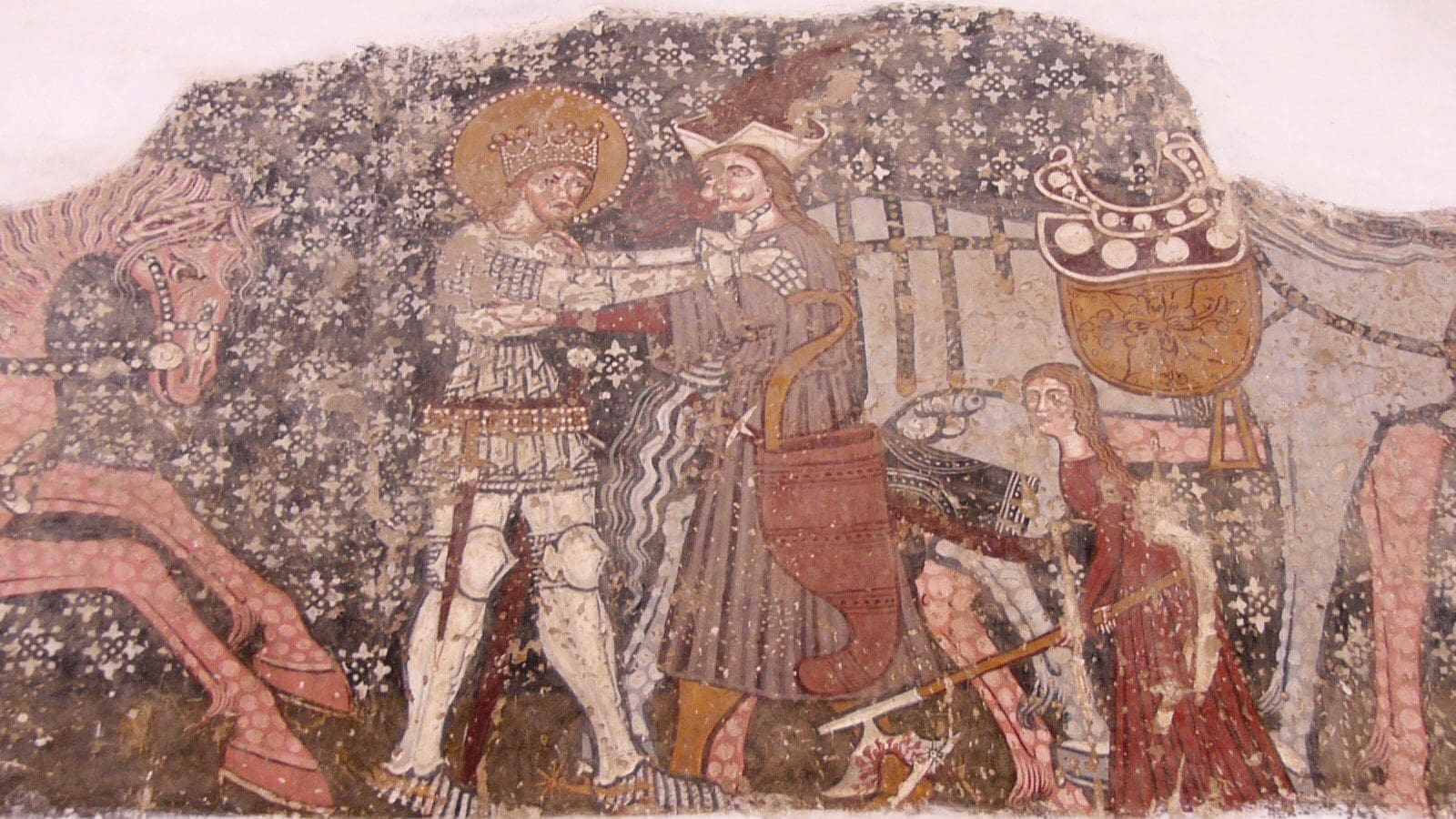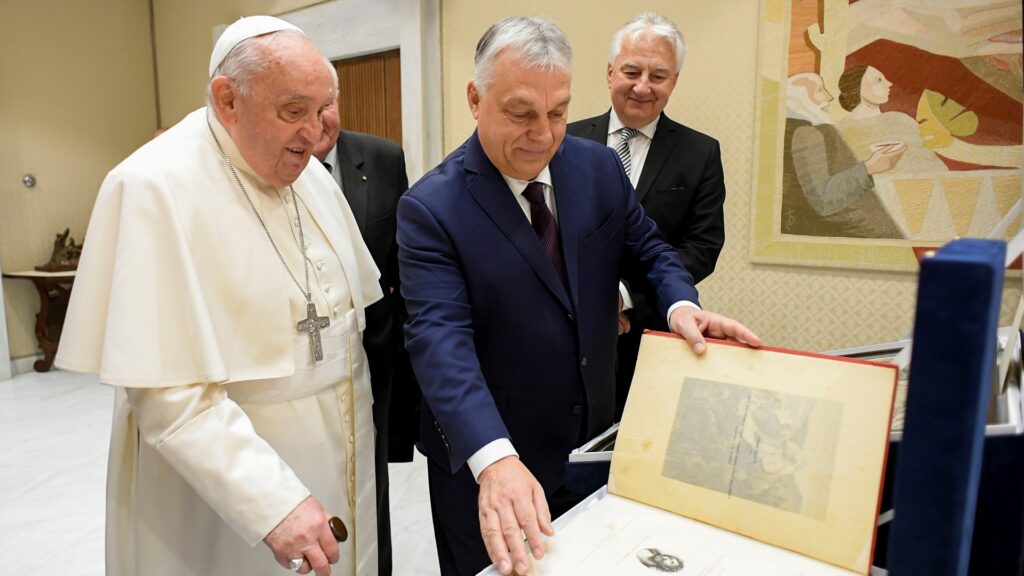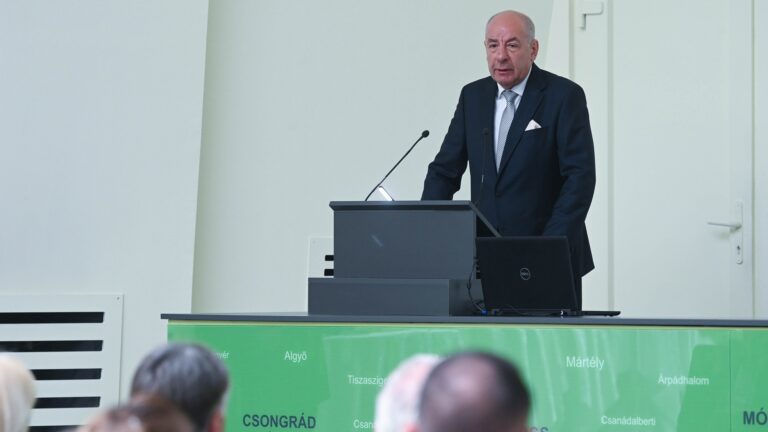Commemorating the anniversary of the canonisation of King Ladislas (Ladislaus), which took place on 27 June 1192, creates an opportunity to delve into the fascinating world of medieval art in Transylvania, with a particular focus on the narrative cycle depicting the legend of the Knight King, an iconic figure in Hungarian history.
This article, featuring the fresco cycles of St Ladislas, was originally published on Hungarian Review.
Our knowledge of medieval wall painting in Transylvania has expanded significantly over the last two decades. The region, which in the Middle Ages was an integral part of the Kingdom of Hungary (and now is part of Romania), boasts an extremely rich heritage in this field. Mural decorations from the 14th and 15th centuries can still be found in village churches dating back to medieval times, having survived later phases of construction and reconstruction. During the last two decades, intensive research and investigation has even uncovered new monuments. Despite recent cuts in funding, this process has sped up during the last few years, to the point where the history of medieval painting in Transylvania needs to be entirely re-evaluated.
As mentioned above, Transylvania, the easternmost region of the medieval Kingdom of Hungary, is an area richly endowed with medieval monuments. The only intact cathedral of medieval Hungary stands at Gyulafehérvár (Alba Iulia/Karslburg), while an emblematic monument, the Black Church of Brassó (Brasov/Kronstadt) marks the easternmost reach of Gothic art in Europe. A nearly unbroken network of medieval churches in villages extends across Transylvania: less densely spread out at the eastern end of the Great Hungarian Plain, and more tightly woven in the centre of Transylvania around Kolozsvár (Cluj–Napoca/Klausenburg), in the regions of Kalotaszeg and Mezőség, and in the eastern Szekler counties. Finally, the network of fortified Saxon churches in Southern Transylvania, and their more modest counterparts in the Szekler counties, as well as a number of Orthodox churches also in Southern Transylvania (especially in Hunyad county) complete the picture. In total, several hundred medieval churches are still standing in Transylvania – ranging from small village churches to the mighty parish churches of large towns as well as the cathedral in Gyulafehérvár.
Their survival over the centuries is due to several factors: first and foremost the region was unaffected by an extended period of Turkish occupation—and the associated wars—which destroyed similar monuments in the centre of the Kingdom; secondly, religious tolerance—for which the Principality of Transylvania is justly famous; and thirdly, the lack of significant economic development during the 18th century, which would likely have resulted in the replacement of the old buildings with new Baroque structures.
Wherever the medieval church buildings still stand, there is a good chance that some of the original painted decorations will be found inside preserved on their walls. Most of these frescoes were covered over at some point of time (many during the 16th–17th centuries due to the Reformation), only to be discovered long after. The process of revealing them began in the late 19th century, and soon brought about some spectacular results: full cycles from the legends of saints, including Hungary’s 11th century king, Saint Ladislas, were uncovered in many churches. This initial wave of discovery, and the publishing activity which accompanied it, came to an end after the First World War, when Transylvania was transferred to the Kingdom of Romania after the Trianon Peace Treaty. Conditions would soon become unfavourable to such research and remained so during the long decades which followed right up to the political changes after the 1989 revolution. After this, however, research commenced once again, often in the framework of cooperation between scholars from Hungary and Romania. New investigations led to significant results concerning the most interesting narrative cycle known from the medieval Kingdom of Hungary: the legend of Saint Ladislas. This overview will concentrate on some new insights we have gained as a result of this process, focusing on the territory of historical Transylvania.
Saint Ladislas, the 11th century king of Hungary (who ruled between 1077 and 1095) was canonised in 1192.
His official legend however does not include a popular episode, which was painted in many churches of the medieval Hungarian Kingdom, depicting Prince Ladislas in the battle of Kerlés fought against the Petchenegs (called Cumans in medieval versions) in 1068. Although the episode is known in art historical literature as the legend of Saint Ladislas, it is a historical narrative, more properly termed a historia, as the inscription on the illustration of the front is piece of the 1488 Augsburg edition of the Thuróczy-chronicle reads. This late representation preserved the key elements of the Saint Ladislas cycle, which had been painted in comparable manner in most surviving 14th-century murals. The usual sequence of scenes is the following: upon hearing of the invading Cumans, Prince Ladislas and the Hungarian army leaves the castle (generally identified as Várad); then a tumultuous battle against the Cumans ensues. Ladislas then notices a Cuman warrior, who has abducted a Hungarian girl, and proceeds to chase him on horseback. The Cuman shoots arrows back at Ladislas, who pursues him with lance in hand—but in vain. In the climax of the narrative, the heroes dismount, and a duel with bare hands follows: they pull at each other’s belt and grab each other’s shoulders, to no avail, until the rescued girl intervenes and cuts the Cuman’s tendon with an axe or sword. The king and the girl then decapitate the Cuman; and finally Saint Ladislas rests under a tree with his head on the girl’s lap, as she touches the king’s hair. In some cycles an additional scene represents the burial of the dead, or related topics.
The textual counterparts of this narrative are only known from 14th century chronicles. The best known example is the text of the Illuminated Chronicle, composed around 1358, which preserved elements of the known and lost chronicles of the 11th and 12th centuries. The author, who called himself Marcus, focused mainly on the most picturesque elements of this tradition. The Illuminated Chronicle is a lavishly illustrated copy of this chronicle composition, presented for King Louis the Great shortly after it was originally written. Part 102 of this chronicle describes the battle against the invading Cumans in detail, while part 103 tells the story of the abducted Hungarian girl.
It is not known when and where the first cycle depicting this story was painted, but the strong similarity of the majority of the cycles indicates the existence of one or two important exemplars. It is clear that the pictorial representation ofthe story was formed with the use of western iconographic and compositional motifs. The iconographic sources of the first half of the cycle, depicting the Hungarian army and the battle are relatively easily identifiable in mid-13th century Crusader art. Illustrated French Old Testament cycles, such as the Morgan Picture Book or the Arsenal Bible show a great variety of battle scenes, with two armies clashing, and dead bodies on the ground.
These cycles, serving as ideological justifications for the Crusades, served in turn as models for the illustrations of Crusader epics and other secular stories, such as the Historia troiana.
The stock formulas of battle scenes employed in these works were easily adaptable for the Saint Ladislas legends. Illustrations of court epics, such as the Song of Roland, and chivalric romances provided other good examples for the scenes of the Saint Ladislas cycle. The use of similar visual topoi is characteristic of the miniatures of the Manesse-codex from the first decades of the 14th century. The cycle and the codex use similar elements belonging to the common heritage of European medieval art.
The cycle, which was constructed in Hungary, is usually built up as a continuous, long narrative cycle. The events follow each other chronologically, the protagonistsare present in every scene, and usually no attention is paid to the surroundings of the events. The trees only mark the divisions between different scenes, which follow each other at a quickening pace. The earliest known examples of the cycle date from the early 14th century, such as Türje in Central Hungary, Kakaslomnic (Veľká Lomnica, Slovakia) and Laskod in Northern Hungary, Bögöz (Mugeni) in Transylvania, restored in 2012. Another type of narrative, probably derived from manuscript painting, coexisted with the continuous narrative type. In these cycles, the scenes are divided by pronounced frames, and they often contain other elements from the legend of Saint Ladislas, not just the battle of Kerlés.
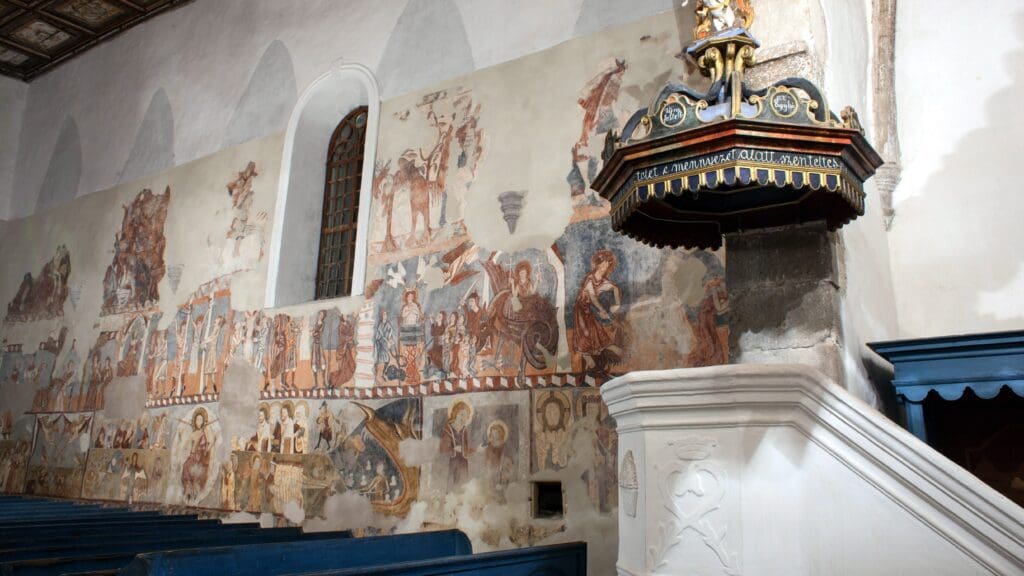
This sequence of separate pictures survived in only one manuscript, the Hungarian Angevin Legendary – but it also appeared in wall paintings. The Legendary, dating from the 1330s, contains the representations of the “official” Ladislas legend, with his miracles – but also includes the battle of Kerlés. The last picture in the episode contains a unique representation, where the hero is cured by the Virgin Mary. Another extended cycle is to be found at Bántornya (Turnišče, Slovenia), painted in 1383 by Johannes Aquila, and it also contains scenes of the founding of the cathedral of Várad, the burial of Ladislas, and others. All these examples as well as other evidence show that the cycle and the cult of Ladislas were prevalent throughout the whole country. Recent research on patron saints shows that Saint Ladislas was equally popular in every part of medieval Hungary. Unfortunately, the central part of the country was devastated by the Turks during the 16th and 17th centuries, and consequently most of the extant Saint Ladislas murals survived only in the border areas.
The popularity of the cycle peaked during the Angevin period (1308-1380), thus shortly after the painted composition was first created. The cycle spread quickly, and by the second quarter of the 14th century it was well known throughout Hungary. The royal court of Charles Robert and Louis the Great could have played an important role in disseminating the cycle most likely in the form of illuminated manuscripts – the only remaining manuscript with the full cycle is the Hungarian Angevin Legendary. The cycle fit perfectly into the revived chivalric ideals of the Angevin kings. Saint Ladislas was, after all, a saint of the chivalry. His historic figure was easy to transform into an ideal knight, as happened with so many beatified rulers during the 12th and 13th centuries. In the painted cycles, the battle and the worldly reward of Ladislas expressed clearly mundane ideas; thus the cycle was especially favoured by the nobility. The late flourishing of the knightly culture which arrived in Hungary with the Drugeth and other noble families in the retinue of the Angevin rulers created an environment receptive to such a cycle, and encouraged its dissemination throughout the country. The nobility could see the figure of the ideal hero in Ladislas, but also that of a warrior fighting against the enemy, just as they did.
The apparel of Ladislas, often called Athleta patriae, follows the changes in fashion and weaponry in the painted cycles, suggesting the influence of the nobility on the depiction of the cycle, moreover their interest in the cycle.
Thus it is not surprising that in most of the documented cases the cycle is found in churches under the patronage of noble families. The cycle at Kakaslomnic was ordered by a certain Magister Kokas, while the Bánffy family ordered the cycle to be painted by Johannes Aquila in 1383 in the centre of their clan at Bántornya. The Transylvanian frescoes were also commissioned by noble families: we see the donors depicted before the cycles in Gelence (Ghelinţa) and Homoródszentmárton (Martiniș), and the praying figures in the first scene of the Bögöz cycle can also probably be correctly identified as donors. One of the latest great cycles, the one at Székelyderzs (Dirjiu) was painted in 1419 under the patronage of Magister Paulus de Ung, as we know from an inscription, written in a scene depicting the conversion of Saul (thus, the story of his patron saint). These cycles clearly expressed the ideals of the noble warriors who commissioned the painters.
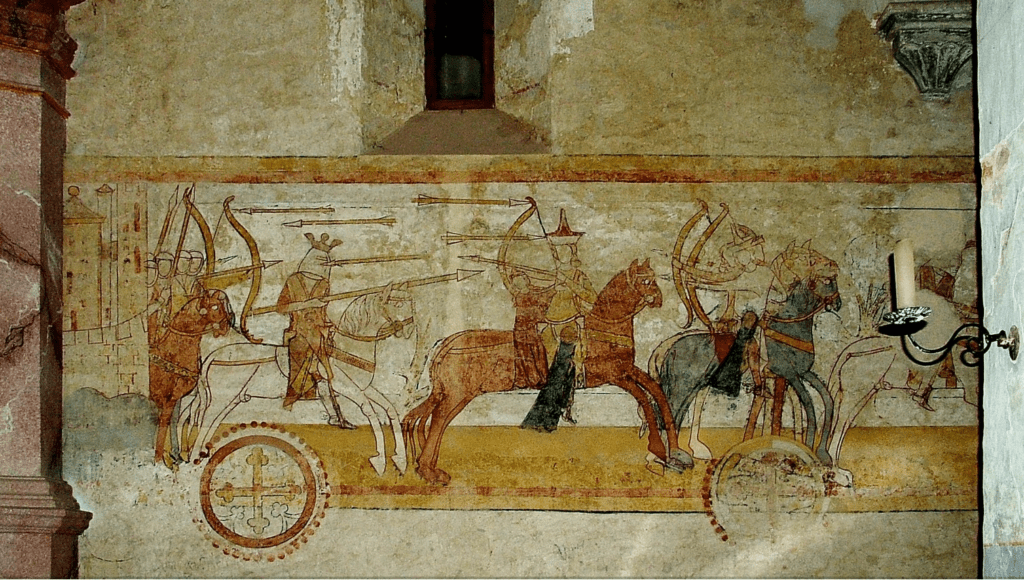
The discovery of several new cycles of the legend in Transylvania has greatly added to our knowledge of these paintings. Listing these new finds in the order of their importance, we have to start with Homoródkarácsonyfalva (Crăciunel), where a previously totally unknown and almost intact cycle of the legend was uncovered by the restorer József Lángi. The cycle, which runs on the northern wall of the nave of the church, tells the full story: from the departure of the Hungarian army from the walls of Várad castle, all the way to Ladislas resting after successfully rescuing the girl. Apart from one missing section (the result of a modern window opened in the wall) and some smaller damages, it is now perhaps the most intact and best quality example of the cycle. Even more important is that its painter was the same one that worked in Gelence, where another completely preserved cycle was discovered by Huszka in 1882. Furthermore, from the copies of Huszka we know that the same workshop was active at two further locations: Homoródszentmárton and Sepsibesenyő (Pădureni). Another cycle, the fragments of which were uncovered at Szacsva (Saciova), belongs to the same group. The discovery of the Homoródkarácsonyfalva cycle also somehow compensates us for the loss of a very similar cycle at nearby Homoródszentmárton – a church which was demolished soon after its frescoes were discovered and copied by József Huszka.
The frescoes date from the first half of the 14th century.
A more exact date is hard to ascertain, and needs further research.
Another group of frescoes dates from the second half and end of the 14th century. Some of these narrative cycles are more provincial, and they were not painted by the same workshop. Some of them – including the frescoes of Maksa (Moacșa) and Erdőfüle (Filia), as well as a second cycle at Sepsibesenyő – are only known from the copies and photos of József Huszka, who originally discovered them. It was, however, possible to uncover and restore one of the key monuments of this group: the wall paintings of the church of Sepsikilyén (Chilieni). Here the cycle is dominated by the frantic battle scene of the Hungarian and the Cuman armies. Fragments of a similar cycle came to light at Székelydálya (Daia), in a church which still awaits its restoration. At Kökös (in Háromszék, today Chichiş), only the first scene of the cycle was found, painted on the western wall of the church: this depicts the Hungarian army getting ready to leave for battle in front of the castle of Várad. The rest of the cycle, which originally occupied the north wall of the church, fell victim to later alterations of the building.
One of the most famous legend cycles of Saint Ladislas was painted at Székelyderzs (Dirjiu), also in the same area as Homoródkarácsonyfalva. Dated by an inscription to 1419, it has been known for a long time that its painter (or rather the workshop) was responsible for other frescoes, including a Calvary scene at Homoród (Homorod/Hamruden), and for the frescoes of Felsőboldogfalva (Feliceni). Although the Székelyderzs cycle has also been known since the research of Huszka, it was nevertheless still possible to add new scenes to it: it was recently revealed that the first scene of the cycle also survived under a layer of white wash.
This newly uncovered scene depicts the Hungarian army riding out of the castle of Várad. Recent years have also brought to light two other, more fragmentary cycles of the legend of Saint Ladislas by the same workshop: at Csíkszentmihály (Mihaileni) and also at Csíkmenaság (today Armășeni—the fresco is partially hidden by a later, Baroque vault of the nave of the church). Two faces reconstructed from archaeological fragments found at the site of the medieval church of Csíkszenttamás (Tomesti) can also be traced to the workshop, and traces of their wall paintings have also been found at Rádos (Roadeș/Radenthal). We thus know the mural paintings of one workshop from several churches, located in two Szekler counties as well as in Transylvanian Saxon villages – a good indication about the mobility and range of medieval painters’ workshops. More art historical research is needed to trace precisely the Central European connections of this workshop. But the discoveries also give a chance to compare different cycles of the Ladislas legend painted by the same workshop in a remarkably small area.
Other discoveries have also forced us to revaluate our theories about the cycle. On account of known examples, it was believed that the cycle was particularly popular among the Szeklers. While this may be true, it should be emphasised that
the cycle was popular throughout the whole of Transylvania—in fact, all of medieval Hungary.
Some recent discoveries inform us about the propagation of the cycle in the central and western areas of Transylvania: the cycle was found in a fragmentary state at Boroskrakkó (Cricau, near Gyulafehérvár/Alba Iulia) and at Magyarremete (Remetea), further to the west. In addition, we are now also aware of a cycle painted for a church of Transylvanian Saxons at Ecel(Ațel/Hetzeldorf), and another discovery has been reported from Szászivánfalva (Ighișul Nou/Sächsisch–Eibesdorf). At Ecel, the three central scenes of the cycle were found in the attic above the sacristy of the church: originally, the cycle was on the exterior wall of the building. This is just one example of numerous discoveries made in Transylvanian Saxon churches, which are slowly beginning to yield their treasures for researchers.
We thus have a much larger body of material to work with, and are now able to discern workshop patterns and iconographical solutions characteristic of different periods. However, many questions still remain. The most interesting of these concerns the origin of the fresco cycle,and in particular the question of when the first painted cycles of the story of Saint Ladislas appeared in the medieval Kingdom of Hungary. At this moment, we do not know any examples which could be dated securely to the late Arpadian period (that is, before 1301).
It seems that the legend appeared in the early phase of the reign of King Charles Robert (1308–1342) of the Neapolitan Angevin dynasty. However, there are several recently discovered monuments, painted on the walls of buildings certainly built during the 13th century—such as Türje in Western Hungary or Boroskrakkó in Transylvania—which compel us to re-examine this question. Even if we cannot prove that the cycle originates in the late Arpadian period—for example, in the atmosphere of anxiety around the time of the feared second Mongol invasion (1270s)—the sudden spread of the cycle during the first decades of the 14th century requires an explanation. The question is connected with that of the origin of the pictorial elements used in the cycle, as discussed above.
There is another very interesting characteristic of Transylvanian frescoes of the legend of Saint Ladislas which should be looked at in more detail: the parallel arrangement of this cycle with that of a female martyr saint, typically Saint Catherine of Alexandria or Saint Margaret. Generally both cycles are continuous narrative cycles, depicted one above the other (as at Homoródszentmárton, Bögöz) or on opposing walls of the nave (at Gelence). The arrangement of these long narrative cycles is essentially Romanesque. The cycles get ample space on the large uninterrupted surfaces of the side walls of church naves. In all these churches clear attempts were made to correlate these cycles, that is to make them part of an even larger decorative system. Such juxtapositions are not uncommon in medieval art, but pairing the legend of a virgin martyr with that of Saint Ladislas is clearly a Hungarian phenomenon.
If we look at the cycles at Bögöz, for example, we can see that the painters consciously emphasised the similarities of the two narratives. The legends of Ladislas and Margaret start in front of identical castles, and both legends develop in a parallel fashion towards their culminations. While Ladislas is fighting with the Cumans, Margaret in the cycle below is fighting with her tormentors. Then in the final section, the similarities of the narrative are also emphasised by similar formal solutions: Ladislas grasps the Cuman with the same gesture as Margaret holds the demons she had defeated.
Ladislas and Margaret defeat evil at the same time, but in the final scene Margaret also gives her life, to get the heavenly crown of virtue. The painter at Homoródszentmárton—where the two cycles were also once depicted one above the other—adds a final parallel: as Margaret is being buried, the body of the defeated Cuman warrior is torn apart by ravens above. The cycles at Bögöz, Homoródszentmárton and Gelence depicted saints who were true to their faith and who set an example for all Christians. The triumphant knights and the martyred virgins are paired as examples, the virgin martyrs showing the ideal way to women, presenting a model of saintly life, while
Ladislas served as example of virtue and model for the knights, also defending Christianity.
The uniquely Hungarian cycle of Saint Ladislas thus emphasises universal values of Christendom—in a pictorial narrative which is one of the most important contributions of Hungary to the medieval art of Europe.

